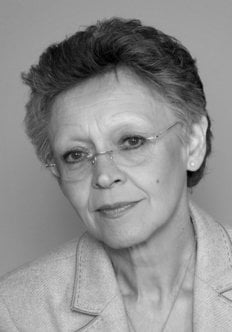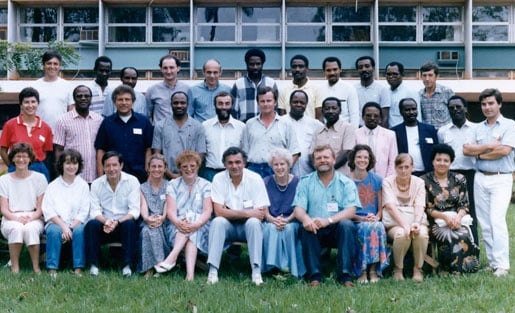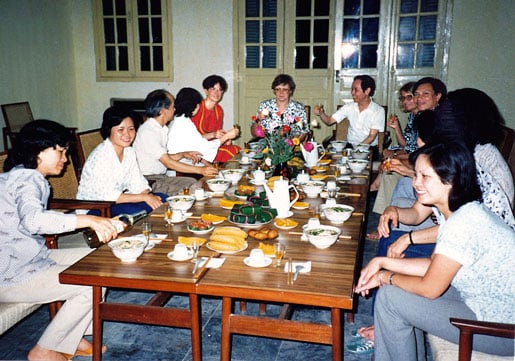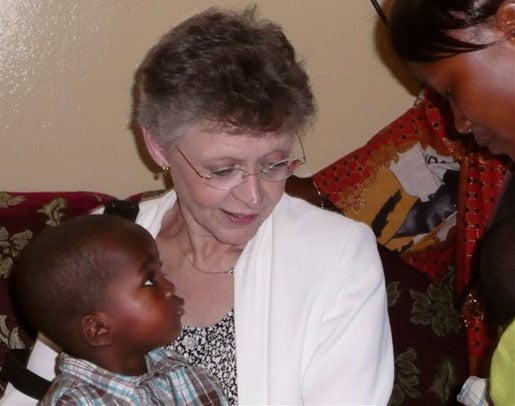Françoise Barré-Sinoussi
Biographical
 I was born in July 1947 in the 19th arrondissement of Paris, the city which remains my home today. My childhood holidays were, however, spent in the Auvergne countryside in central France, where I was content to spend my days outdoors, observing the wonders of the natural living world. Even the smallest of insects could capture my attention for hours. This fascination for the natural world was perhaps the earliest indication of the future direction my life would take.
I was born in July 1947 in the 19th arrondissement of Paris, the city which remains my home today. My childhood holidays were, however, spent in the Auvergne countryside in central France, where I was content to spend my days outdoors, observing the wonders of the natural living world. Even the smallest of insects could capture my attention for hours. This fascination for the natural world was perhaps the earliest indication of the future direction my life would take.
During my school years, my passion for science was reflected in my grades, which were by far better in scientific subjects than in languages and philosophy. Having completed my baccalauréat in 1966, I was initially undecided between medicine and biomedical sciences as the subject for my university studies. I finally decided to opt for an undergraduate degree at the Faculty of Sciences at the University of Paris. My choice was ultimately dictated by the pragmatic reasoning that a degree in Natural Sciences was shorter and less expensive than a degree in Medicine, and I was keen to not have to burden my family with unnecessary further expenses to support me during my studies. Towards the end of my degree, I seriously questioned the possibility of research as a career option. It was therefore important for me to gain laboratory experience to clarify these doubts about my future. I contacted a large number of both private and public laboratories offering to volunteer part-time at the bench. My search for a host laboratory proved fruitless for many months. It was only when a friend of mine from university suggested contacting a group with whom she had been collaborating that I finally found a laboratory willing to host me as a volunteer. The group was led by Jean-Claude Chermann at the Institut Pasteur site at Marne-la-Coquette. Chermann was studying the relationship between retroviruses and cancers in mice. Very early on he transmitted so much passion and enthusiasm for the research I was doing, that, although I was supposed to continue attending classes for my degree, I spent all my time in the lab and only made an appearance at the university site to pass the necessary exams. Very quickly after my arrival in the Chermann group, Jean-Claude proposed a PhD project. My project analysed the use of a synthetic molecule which inhibited the reverse transcriptase to control leukaemia induced by Friend virus. This synthetic molecule, named HPA23, proved capable of inhibiting reverse transcriptase activity of Friend virus in culture. Pre-clinical tests showed that the molecule was capable of delaying the progression of the disease in mice. I completed my PhD relatively rapidly, as Jacques Monod, director of the Institut Pasteur at the time, had decided to move all external sites of the institute (including the Marne-la-Coquette site) back to the main campus in the 15th arrondissement of Paris. The move of the laboratory to the main campus would have proved a confusing time, and I was eager to complete my PhD before the move. I was awarded my PhD in 1974 by the Faculty of Sciences at the University of Paris.
During my time as a PhD student, the group was visited by Dr Dan Haapala and Dr Robert Bassin, two researchers from the National Cancer Institute (NCI) of the National Institutes of Health (NIH) in the United States, for a sabbatical research period. Furthermore, a member of this lab had been in our group teaching us the technique for the detection of reverse transcriptase, soon after the discovery of this enzyme by David Baltimore and Howard Temin. Following these contacts, I decided to join Bob Bassin for a post-doctoral research fellowship at the NIH in Bethesda in the mid-70s. My research project was a challenging one, aiming to identify the viral target of the Fv1 gene product implicated in the genetic restriction of murine leukaemia virus replication. Although the project was difficult, my experience at the NIH was a truly enriching one, albeit relatively short. I only remained one year in the United States, as during my PhD I had met my future husband, whom I later married in 1978. In addition, while in the US I discovered that I had been awarded an INSERM (National Institute for Health and Medical Research in France) position to return to Jean-Claude Chermann’s laboratory (which had in the meanwhile moved to the central Pasteur campus) in the unit of Professor Luc Montagnier.
The group, which was slowly expanding in size in the late 70s and early 80s, was one of the few groups which continued to study the link between retroviruses and cancers. Indeed, many others had turned their attention to oncogenes, whose crucial role had been illustrated in the mid-70s by J. Michael Bishop and Harold Varmus. My research project at the time was to study the natural control of retroviral infections in the host, in particular the role of interferon in controlling endogenous retroviruses, and the functional implication of retroviral sequences on the metastatic potential of tumour cells in mouse models.
In late 1982, Luc Montagnier was contacted by Françoise Brun-Vézinet, a virologist working at the Bichat Hospital in Paris. Françoise Brun-Vézinet was working closely with Willy Rozenbaum, one of the first clinicians in France to observe the alarming new epidemic, which seemed to be affecting certain homosexuals. Willy had observed a number of cases in his ward, and had made the link with the Centres for Disease Control (CDC) report which had been published in 1981. After this first contact, Luc Montagnier asked me whether I was interested in working on this new project to determine whether a retrovirus could be responsible for the disease. After discussion with Jean-Claude Chermann, we accepted the proposal. We had previously detected mouse mammary tumour virus (MMTV) sequences in the lymphocytes of breast cancer patients, and we were familiar with the technique of reverse transcriptase activity detection. It would have been a relatively routine procedure to detect the presence of a retrovirus, and we were obviously keen to determine whether a retrovirus was present in patients affected by this newly described disease (later to be known as AIDS).

Figure 1. Detection of HIV infection course at Institut Pasteur in Bangui, Central African Republic, 1987.
In late December 1982, meetings were held between our group at the Institut Pasteur and Willy Rozenbaum and Françoise Brun-Vézinet. The clinical observations suggested that the disease attacked the immune cells, but the strong depletion of CD4 lymphocytes greatly hindered the isolation of the virus from these rare cells in patients with AIDS. We therefore decided to use a lymph node biopsy from a patient with generalised lymphadenopathy. We waited until the new year to obtain the first patient biopsy from which lymphocytes were isolated and cultured. The cell culture supernatant was regularly tested for reverse transcriptase activity. The first week of sampling did not show any reverse transcriptase activity, but in the second week I detected weak enzymatic activity, which increased significantly a few days later. The reverse transcriptase activity level dropped dramatically however, as the T lymphocytes in the culture were dying. To save the culture, with the hope of preserving the virus, we decided to add lymphocytes from a blood donor to the cell culture. This idea proved successful, and as we had hoped, the virus − which was still present in the cell culture − started to infect the newly added lymphocytes and we were soon again able to detect significant reverse transcriptase activity. We named this newly isolated virus lymphadenopathy associated virus (LAV). At this point it was important to visualise the retroviral particles, and Charles Dauguet, in charge of the microscopy platform at Pasteur, provided the first images of the virus in February 1983.
The isolation, amplification and characterisation of the virus rapidly ensued, and the first report was published in Science in May 1983. In the same month, I presented our findings at the annual Cold Spring Harbor Meeting, after which I was invited by researchers at the CDC and by others at the NIH in Bethesda to discuss the results in further detail. During the following months, we continued to characterise this newly isolated virus, and a collaboration with molecular biologists at the Institut Pasteur determined the genome sequence. The collective efforts by researchers in our group and others, and by clinicians, brought together sufficient data to convince the scientific community and the relevant authorities that LAV (later to be named human immunodeficiency virus, HIV) was the etiological agent of AIDS.
The year 1983 marked the beginning of my career in HIV research at the Institut Pasteur, which still continues to this day. I remained at the Institut Pasteur, even after the departure of Jean-Claude Chermann in 1987, and I was finally appointed as head of the Biology of Retroviruses Unit in 1992. My professional life has been intrinsically linked with collaboration with resource-limited countries. My first visit to an African country was in 1985, on the occasion of a World Health Organisation (WHO) workshop in Bangui (Central African Republic). This visit was an eye-opening experience. The culture shock and dire conditions impressed me greatly and instilled in me a desire and necessity to collaborate with resource-limited countries. My first visit to Vietnam in 1988 was the first of many visits, and the first collaborative steps with Asian countries. This long-lasting collaboration with Africa and Asia has resulted in continual exchanges between young scientists from the respective countries and researchers in Paris.

Figure 2. A visit to the National Institute of Hygiene and Epidemiology, Hanoi, Vietnam, 1988.
My unit at the Institut Pasteur was re-confirmed in 2005 and re-named the Regulation of Retroviral Infections Unit. The unit hosts approximately 20 people at any one time, consisting of students, post-docs and permanent research staff. Currently the unit is interested in defining the immune correlates of protection against HIV infection for vaccine research and the correlates of protection against AIDS for immunotherapy. Along these lines, the unit is focusing its research on the mechanisms of host control of HIV infection, both at the cell level and at the level of the immune response. We are studying examples of natural protection against infection, such as HIV-exposed but uninfected individuals (EU) and the placental barrier against HIV in-utero transmission; or of natural protection against disease, such as HIV controllers (HIC) and animal models of non-pathogenic infection (African Green Monkey, AGM /SIVagm).

Figure 3. A recent visit to Yaoundé, Cameroon, 2008.
Although I anticipate continuing my professional endeavours largely unchanged by the Nobel Prize, I hope that this recognition will provide the necessary spark to spur international efforts in the fight against HIV/AIDS.
This autobiography/biography was written at the time of the award and later published in the book series Les Prix Nobel/ Nobel Lectures/The Nobel Prizes. The information is sometimes updated with an addendum submitted by the Laureate.
Nobel Prizes and laureates
Six prizes were awarded for achievements that have conferred the greatest benefit to humankind. The 14 laureates' work and discoveries range from quantum tunnelling to promoting democratic rights.
See them all presented here.
